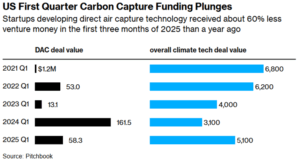Solar installations surge, the dangers of fast charging and biofuel breakthrough
In this issue:
Solar installations surge
On the back of last week’s news of growth in wind, this week SolarPower Europe published its Global Market Outlook revealing a 33% increase in solar installations in 2024 over 2023. China added 329GW in the year, 55% of all installations, that totalled 597GW. The report predicts installations will reach 1TW a year by 2030. Total global capacity reached 2TW by the end of 2024.
Careful what you wish for on EV charging
Scientists from Tsinghua University (China) have found EV batteries regularly charging at over 120kW experience a 40% decline in battery life, compared to those using slow chargers. With batteries being the single most expensive replacement for EVs, this throws attention on the warranties on battery life and their terms and conditions, such as ownership transfer. The recommendations are that owners prioritise slow charging when they can, limit ultra-fast charging to around 40% of total charging sessions and not use ultra-fast charging if the battery is below 10% or above 90% charge, as this further reduces lifespan.
Energy hunger outweighs climate ambition
That’s the conclusion of a new report from EY that surveyed 2,400 people in large or medium sized businesses across eight global markets. While many of the companies expressed ambitions to reduce their emissions, the fundamental need of staying in business and accessing energy will see these ambitions compromised. 80% of the respondents indicated they expect their energy demand to grow over the next three years and two thirds indicated concern about their ability to access a reliable electricity supply. About 20% reported they have installed on-site generation and batteries to improve security of supply.
Biofuel breakthrough
The US has an abundance of waste from its corn industry. The stalks, husks and leaves, collectively known as corn stover, are either burned or tilled back into the soil because conversion into biofuel requires expensive chemical recovery. Scientists from Washington State University have a developed a new pre-treatment that converts the stover into sugar at a cost of around US$0.60 (NZ$1) a kilo, a price competitive with imported sugar.
Climate adaptation to be a lucrative business
Market revenues for certain climate adaptation solutions are expected to increase four fold by 2050 from a current market size of US$1trn (NZ$1.7trn) to US$4trn (NZ$6.7trn), according to Singaporean investment house GIC. Two thirds of the growth will be driven by global warming, regardless of which of the common temperature increase scenarios eventuates.
Wealthiest doing most harm
The world’s wealthiest 10% have caused two thirds of global warming since 1990, according to the latest research from the International Institute for Applied Systems Analysis. It goes on to report the wealthiest 1% contributed 26 times the global average to the frequency of extreme heat events and that if everyone had emissions consistent with the bottom 50% of the global population (by wealth), we pretty much wouldn’t have a climate problem.
Investors deserting carbon capture
Venture capital investments in direct air carbon capture plummeted 60% in the first quarter of 2025 compared with the same quarter last year, according to a new analysis by Bloomberg. While investment in Q1 2024 was unusually high, meaning the fall seems dramatic, it comes against a backdrop of an overall increase of 64% in investments into climate tech, indicating DAC is very much seen as a weak investment prospect at the moment. The Bloomberg report suggests companies are struggling to reduce the cost of direct capture with technologies currently running at costs of US$1,000 (NZ$1,669) per tonne of CO2 captured.
Rooftop panels to be mandatory
That’s almost certain to be the case in the UK from 2027 as Ministers’ hands are poised over applying final signatures according to the UK press. Almost all new homes built from then will be required to have panels installed within two years of construction starting. Sounds like a plan.
Did you know …….
Some bacteria breathe by generating electricity? Researchers at Rice University have discovered certain bacteria rely on naphthoquinones to transfer electrons to external surfaces to create energy, a process that replaces the more common use of oxygen to facilitate the transfer. The authors claim the process could be adapted to deliver practical volumes of electricity.


